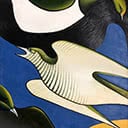Saint Francis and the Wolf, 2007 - 2018
120 x 100 cm
est. $120,000 - 160,000
 Relative size
Relative size
PROVENANCE
Collection of the Artist
Completed over a period of nearly twelve years, Saint Francis and the Wolf is a major work by the artist which contemplates spirituality, the environment and harmony between man and members of the animal kingdom. It is based on the story of a lone wolf which terrorised the Umbrian town of Gubbio in 1220, attacking both livestock and inhabitants. The townspeople had heard that through grace, Francis of Assisi was able to communicate with creatures great and small. In desperation they appealed for his help. Francis went up into the hills and met with the wolf. After calming the animal whom he addressed as Brother Wolf, it was proposed that should attacks upon the townspeople cease, they in return would feed him. In a gesture of submission and agreement the wolf placed his paw in Francis' hand and the pact was sealed. This legend has been portrayed by artists throughout the ages.
Michael Smither was raised within the Catholic faith and a number of his works depict religious themes and stories. In St Joseph's church, New Plymouth, the artist's concrete-cast stations of the cross are accompanied by two striking murals, Doubting Thomas and The Baptism of Christ. These are situated in a contemporary setting - Jesus in a wetsuit, being baptised on a rocky Taranaki riverbed.
In keeping with the centuries old tradition of adapting religious stories to local settings, Smither has nestled the Italian duo beneath a border of New Zealand ferns. The scene appears fresh, hyper-realistic and the brightness of the ferns is such that they resist any incongruity. The rock held by St Francis, and around which his figure is centred, recalls both the eucharistic bread and the similar forms of the artist's rock paintings.
On one level, this painting may be seen as a simple depiction of a man and his dog. This interpretation offers some insight into the artist's relationship with Catholicism, and his definition of spirituality which he described as belonging to every man and his dog. To this statement Smither added, and that's why St Francis has always been my favourite saint. He's the person who related to the whole world, right down to the sticks in the fire and the straw on the ground. Given St Francis' connection to the natural environment - he is the patron saint of animals and ecology - it is unsurprising that Smither favoured him in such a way.
Through this painting and his other depictions of St Francis, Smither has joined a vast artistic tradition including direct influences such as Stanley Spencer (the artist refers to a postcard sent by his friend John Maynard depicting Spencer's St Francis and the Birds and other New Zealand artists such as Colin McCahon Can You Hear Me, St Francis, 1969.




